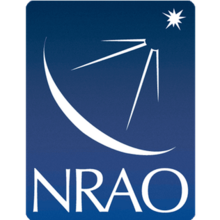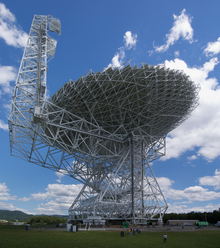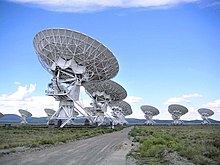National Radio Astronomy Observatory
 | |
 | |
| Alternative names | NRAO |
|---|---|
| Organization | |
| Location | United States |
| Coordinates | 38°02′12″N 78°31′05″W / 38.0368°N 78.5181°W |
| Established | 1959 |
| Website | public |
| Telescopes | |
| | |
The National Radio Astronomy Observatory (NRAO) is a federally funded research and development center of the United States National Science Foundation operated under cooperative agreement by Associated Universities, Inc. for the purpose of radio astronomy. NRAO designs, builds, and operates its own high-sensitivity radio telescopes for use by scientists around the world.[1]
Locations
[edit]Charlottesville, Virginia
[edit]The NRAO headquarters is located on the campus of the University of Virginia in Charlottesville, Virginia. The North American ALMA Science Center and the NRAO Technology Center and Central Development Laboratory are also in Charlottesville.[2]
Green Bank, West Virginia
[edit]
NRAO was, until October 2016, the operator of the world's largest fully steerable radio telescope, the Robert C. Byrd Green Bank Telescope, which stands near Green Bank, West Virginia.[3] The observatory contains several other telescopes, among them the 140-foot (43 m) telescope that utilizes an equatorial mount uncommon for radio telescopes, three 85-foot (26 m) telescopes forming the Green Bank Interferometer, a 40-foot (12 m) telescope used by school groups and organizations for small scale research, a fixed radio "horn" built to observe the radio source Cassiopeia A, as well as a reproduction of the original antenna built by Karl Jansky while he worked for Bell Labs to detect the interference that was discovered to be previously unknown natural radio waves emitted by the universe.[4]
Green Bank is in the National Radio Quiet Zone, which is coordinated by NRAO for protection of the Green Bank site as well as the Sugar Grove Station monitoring site operated by the NSA. The zone consists of a 13,000-square-mile (34,000 km2) piece of land where fixed transmitters must coordinate their emissions before a license is granted. The land was set aside by the Federal Communications Commission in 1958. No fixed radio transmitters are allowed within the area closest to the telescope. All other fixed radio transmitters including TV and radio towers inside the zone are required to transmit such that interference at the antennas is minimized by methods including limited power and using highly directional antennas. With the advent of wireless technology and microprocessors in everything from cameras to cars, it is difficult to keep the sites free of radio interference. To aid in limiting outside interference, the area surrounding the Green Bank Observatory was at one time planted with pines characterized by needles of a certain length to block electromagnetic interference at the wavelengths used by the observatory. At one point, the observatory faced the problem of North American flying squirrels tagged with United States Fish and Wildlife Service telemetry transmitters. Electric fences, electric blankets, faulty automobile electronics, and other radio wave emitters have caused great trouble for the astronomers in Green Bank. All vehicles on the premises are powered by diesel motors to minimize interference by ignition systems.[5][6]

Until its collapse on November 15, 1988, a 300 ft radio telescope[7] stood at the Green Bank Observatory's unique site. It was the largest radio telescope on Earth when it was brought online for its first observation at 12:42 am on September 21, 1962. The telescope's first observation was of the remnants of Tycho's supernova that had exploded 11 November 1572. Two major overhauls installed a new surface in 1970 to correct for maintenance, snow damage, and warping from its sheer size; then a new, bigger project building was constructed in 1972 that incorporated a Farady cage around the control room itself. The telescope stood at 240 ft in height, weighed 600 tons, had a 2-minute arc accuracy, and had a surface accuracy of ~1 inch. The collapse in 1988 was found to be due to unanticipated stresses which cracked a hidden, yet weight- and stress-supporting steel connector plate, in the support structure of the massive telescope. A cascade failure of the structure occurred at 9:43 pm, causing the entire telescope to implode. The debris from the collapse was cleared by June 1989, and West Virginia Senator Robert C. Byrd would pioneer a campaign in Congress to replace it with the Green Bank Telescope, construction for which began in 1990.
Socorro, New Mexico
[edit]
The NRAO's facility in Socorro is the Pete Domenici Array Operations Center (AOC). Located on the New Mexico Tech university campus, the AOC serves as the headquarters for the Very Large Array (VLA), which was the setting for the 1997 movie Contact, and is also the control center for the Very Long Baseline Array (VLBA). The ten VLBA telescopes are in Hawaii, the U.S. Virgin Islands, and eight other sites across the continental United States.[8]
Tucson, Arizona
[edit]Offices were located on the University of Arizona campus. NRAO formerly operated the 12-Meter Telescope on Kitt Peak. NRAO suspended operations at this telescope and funding was rerouted to the Atacama Large Millimeter Array (ALMA) instead.[9] The Arizona Radio Observatory now operates the 12-Meter Telescope.[10]
San Pedro de Atacama, Chile
[edit]The Atacama Large Millimeter Array (ALMA) site in Chile is at ~5,000 m (16,000 ft) altitude near Cerro Chajnantor in northern Chile.[11] This is about 40 km (25 miles) east of the historic village of San Pedro de Atacama, 130 km (81 miles) southeast of the mining town of Calama, and about 275 km (171 miles) east-northeast of the coastal port of Antofagasta.[12]
Jansky Prize
[edit]The Karl G. Jansky Lectureship is a prestigious lecture awarded by the board of trustees of the NRAO. The Lectureship is awarded "to recognize outstanding contributions to the advancement of radio astronomy."[14] Recipients have included Fred Hoyle, Charles Townes, Edward M. Purcell, Subrahmanyan Chandrasekhar, Philip Morrison, Vera Rubin, Jocelyn Bell Burnell, Frank J. Low, and Mark Reid.[15] The lecture is delivered in Charlottesville, Green Bank, and in Socorro.
See also
[edit]References
[edit]- ^ "National Radio Astronomy Observatory". National Radio Astronomy Observatory. Retrieved 20 May 2019.
- ^ "Maps & Directions". Nrao.edu. Retrieved 20 May 2019.
- ^ "NRAO Structural Changes: Announcing the Separation of the Green Bank Observatory and the Long Baseline Observatory". Associated Universities, Inc. 29 March 2016. Retrieved May 20, 2019.
- ^ "Other Telescopes at Green Bank". Gb.nrao.edu. Retrieved May 20, 2019.
- ^ "National Radio Quiet Zone — Science Website". Science.nrao.edu. Retrieved May 20, 2019.
- ^ "NRAO Green Bank Site RFI Regulations for Visitors" (PDF). Gb.nrao.edu. Retrieved May 20, 2019.
- ^ "300-ft telescope at Green Bank Site". Gb.nrao.edu. Retrieved August 17, 2022.
- ^ "NRAO: Socorro, New Mexico". Aoc.nrao.edu. Retrieved 20 May 2019.
- ^ "National Radio Astronomy Observatory – Legacy Content – Tucson". Legacy.nrao.edu. Retrieved 20 May 2019.
- ^ "Arizona Radio Observatory". Aro.as.arizona.edu. Retrieved 20 May 2019.
- ^ "ALMA". Almaobservatory.org. Retrieved 20 May 2019.
- ^ "ALMA Location". Almaobservatory.org. Retrieved 20 May 2019.
- ^ "Halfway There: 33 ALMA Antennas on Chajnantor". ESO Announcement. Retrieved 15 May 2012.
- ^ "Jansky Lecture Redirect". Nrao.edu. Retrieved 20 May 2019.
- ^ "2012 Jansky Lecturer". Nrao.edu. Retrieved 20 May 2019.
External links
[edit]- Radio observatories
- Astronomy institutes and departments
- Federally Funded Research and Development Centers
- University of Virginia
- National Science Foundation
- Radio astronomy research institutes
- Research institutes in Virginia
- Science and technology in Virginia
- Research institutes established in 1956
- Scientific organizations established in 1956
- 1956 establishments in Virginia
- Organizations based in Virginia


